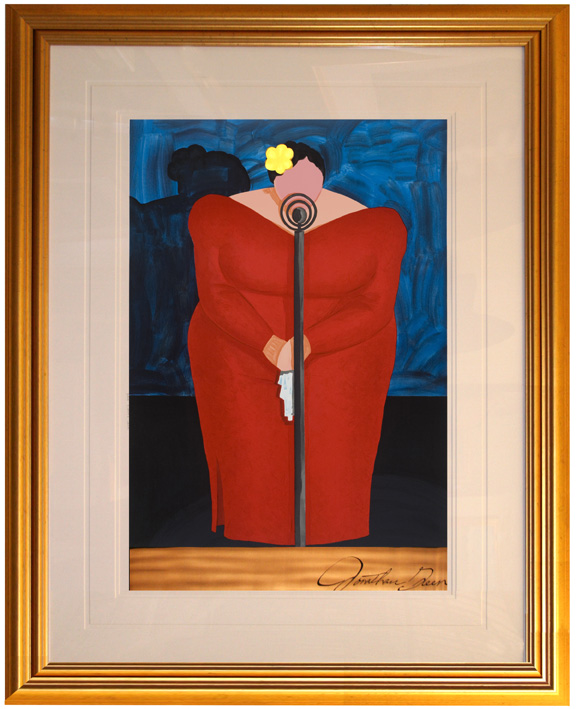
Jonathan Green | John W. Jones | Leroy Campbell | Carol A.Simmons | James Denmark

|
Title: Bessie Mae Image size: 28" x 40" Framed size (approx.): 46" x 58" approx Net Cost with Frame $895.
|
|


|
Title: Bessie Mae Image size: 28" x 40" Framed size (approx.): 46" x 58" approx Net Cost with Frame $895.
|
|
Jonathan Green Photo
Essay
Now With Bill Moyers
Discover the Art of Jonathan Green
For many people discovering the art of Jonathan Green for the first time, it's usually a case of surprised delight. Many people ask, "why have I missed knowing about such beautiful works". In fact those who profess to be expert collectors and upto date on all the popular artists are almost annoyed they have not discovered the art of Jonathan Green until now.
Painter and Printmaker Jonathan Green was born and raised in the small Gullah community of Gardens Corner, located near the Sea Islands of South Carolina. From the moment of his birth, Jonathan Green was special child. He was born with a caul-an inner fetal membrane covering the head at birth-that some believe is a sign "that the child is touched by uncommonness and magic that will bring inordinate grace to the community". Jonathan Green was raised by his grandmother in a matriarchal society that relied heavily on oral traditions. As a special child, he was deferred to and taught many things about his people, their traditions and their beliefs. " I was always interested in things, in how crafts were done, who everyone's relatives were and the religious functions of the community," says Jonathan Green "I had all these stuff in my head but I didn't have a place for it until I started painting."
The following article by Carroll Greene Jr. best describes the art of Jonathan Green.
COMING HONE AGAIN
ARTIST JONATHAN GREEN
RETURNS TO HIS GULLAH ROOTS
By Carroll Greene Jr.
American Visions, volume 5, Number 1, February 1990, pgs 44 - 52.
When artist, Jonathan Green talks about growing up in South Carolina's Low Country in the 1960s, one begins to realize that through his art he hopes to recapture a quintessential part of himself. There is a certain urgency and depth of purpose.
"My culture is in me, Jonathan Green says. "And my art is connected to the spiritual, mental and social concerns of the global environment." He seeks to recall the feel, texture and color of a way of life he knows is rapidly disappearing. And quite literally on some of the islands near his mother's home, a way of life is being bulldozed out of existence in the name of progress: condos, highways, fast-food chains and displacement of people.
"I know I can't save a whole culture," laments Jonathan Green, "but as an artist I can help create greater awareness perhaps. All of the change is not bad. But are they throwing out the baby with the bath?"
Some 250,000 African-Americans known as Gullahs in South Carolina and Geeches in Georgia are clustered along the Atlantic Coast--from Jacksonville, N.C., to Jacksonville, Fla. The word Gullah probably came from Angola, home of some of the Africans brought to the region during slavery. The Low Country is a place of broad flatlands, marshes, numerous inlets, rivers and islands bordering the Atlantic--romantically called Sea Islands.
Jonathan Green learned the Gullah dialect and culture as a child growing up in the home of his maternal grandmother. After leaving the area to study art, he has now returned to give the Gullah life he recalls his own aesthetic vision. It is an artistic odyssey that has come full circle.
Through the years many African-American artists, such as painters Eldzier Cortor and Ellis Wilson, photographer Jeanne Moutoussamy-Ashe, and the late folk artist Sam Doyle, a native to the area, has featured the colorful Low Country and its people in their work. But Green's body of work, about 150 Gullah works, is perhaps the most ambitious artistic expression of Sea Islands' culture ever successfully undertaken.
Jonathan Green's most vivid memories of Gullah life are culled from the 160s. " I can remember things as a child that are on now-such as hair wrapping, men weaving fishing nets, farming and hunting. There is very little of these activities going on now. What fishing and hunting that goes on is mainly sport and not out of necessity as before. Food used to be preserved in various ways drying, canning, and smoking. Now, only gardening seems to continue. Mattresses were made of Spanish moss, and men made furniture for use in the community."